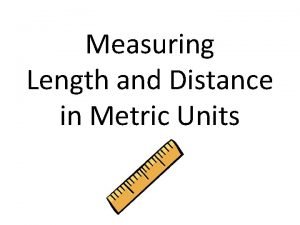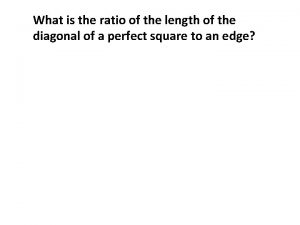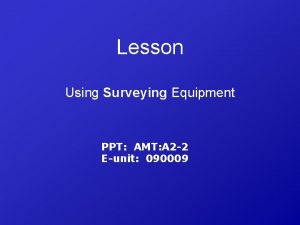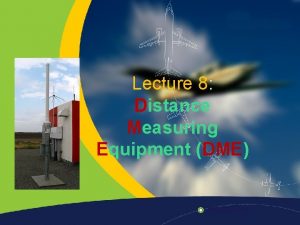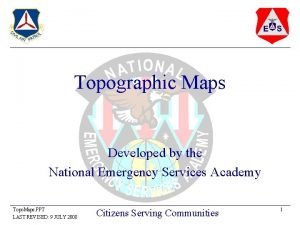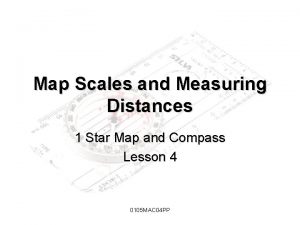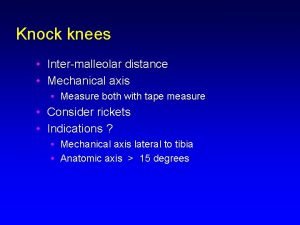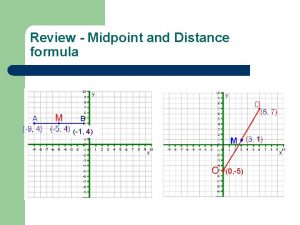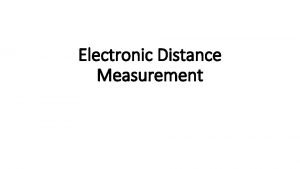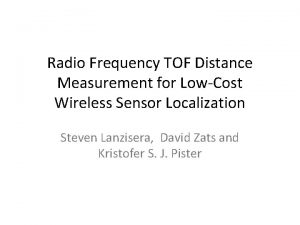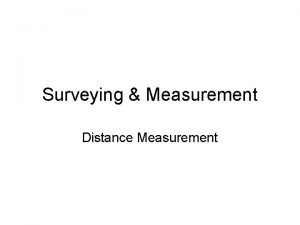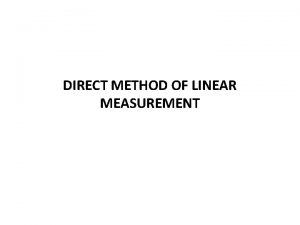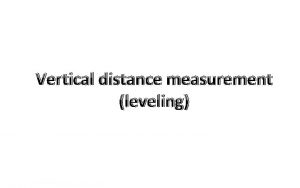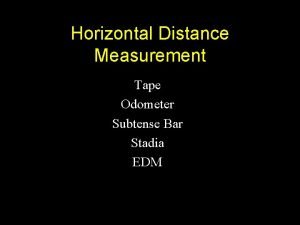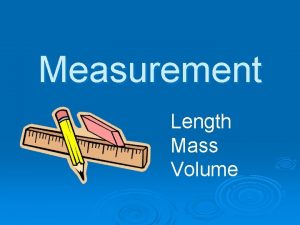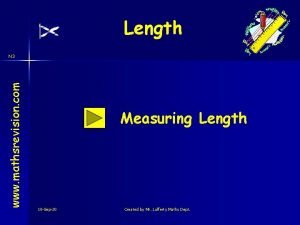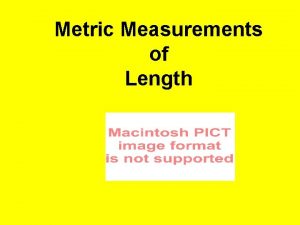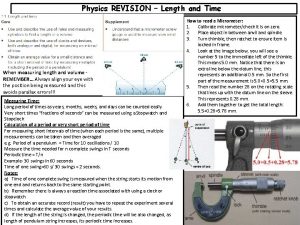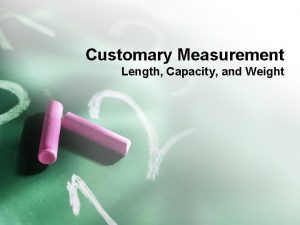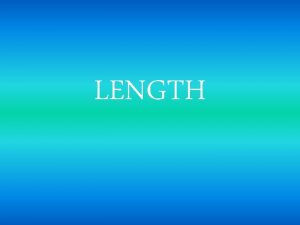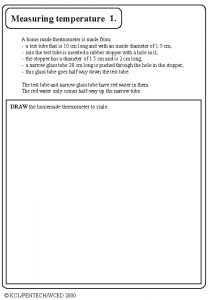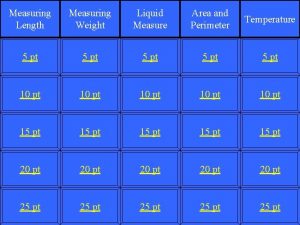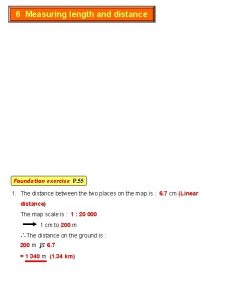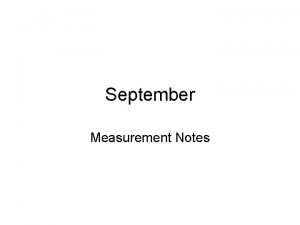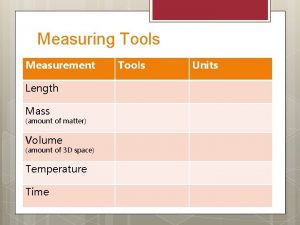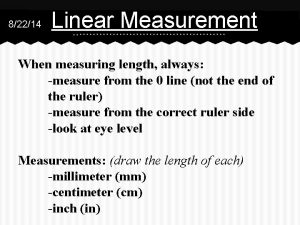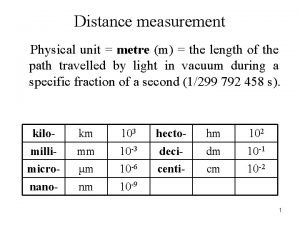Measurement Measuring Distance Distance is the length from

























- Slides: 25

Measurement

Measuring Distance • Distance is the length from one point to another • The tool we use in class to measure distance is the ruler or meter stick. • Meter: basic unit of distance in the metric system • Centimeter: • 100 centimeters make a meter. • A cm is 1/100 of a meter • Kilometer: • 1, 000 meters. • • Millimeter: 1000 millimeters make a meter. 10 millimeters make a cm. One mm is 1/1000 of a meter.

How to measure objects to the nearest tenth of a cm , 0. 1 cm • Always start at zero. • Then read the biggest number covered by the object. Those are the centimeters. Write that to the left of the decimal. • Then count the lines. Those are the tenths of a cm. • Write them to the right of the decimal. • Remember units! funbrain


Five things you need on every graph before you plot the points • 1. Title • 2. Axis • 3. Intervals • 4. Label for axis with units • 5. Scale for x and y axis • Think TAILS!

How to plot points on a graph 1. Find points on the correct axis X and y, (depending on data and label on axes) For example 300 mm of pressure and 75 degrees centigrade is marked

How to plot points on a graph 2. Draw or run fingers along the horizontal and vertical lines from the points on the axes

How to plot points on a graph 3. Where lines meet, plot the point.

Rules for drawing a best fit line • Use a ruler to make a straight line • The line must go as close as possible to all the points • The line must extend all the way across the graph

How to find information using the best fit line on the graph Find value given in the problem on the correct axis. Run your finger straight along that line until you get to the graphing line. Then read across or down to the value on the other axis. There is your answer.

Do Now: • Which has more mass, a kilogram of bricks or a kilogram of feathers? Explain on p. 16

Measuring Mass • Mass is the amount of matter in a substance • Mass is not the same as weight. Weight is the pull of gravity on mass. Mass does not change depending on where you are but weight changes depending on where you are – for example the moon. • The tool we use to measure mass is the triple beam balance. • The basic unit of measure of mass is the KILOGRAM (kg). • Grams are abbreviated g. • Kilograms = Kg 1 Kg = 1, 000 g • milligrams = mg 1000 mg = 1 g • Draw a picture of the difference between mass and weight. • Video of How to Use a Triple Beam Balance

Rules for using the Triple Beam Balance • 1. Always use two hands to carry the balance. • 2. Never put too much weight on - not more than a textbook. • 3. Always start at zero. • 4. Start with the heaviest rider. • 5. Always fit the riders in the notches. • 6. Line up the decimals when you add the masses on each rider.

The mass here is 60+2. 5 =62. 5 G

Do Now continued • 2. What is the mass of the beaker and sand in the second picture? • 3. If the mass of the beaker is 14. 5 g, what is the mass of the sand? • Hint: what did we do yesterday with the gum and wrapper?

Do Now: Explain this cartoon on p 37 bottom

Volume: The amount of space an object takes up • • • The basic unit of volume is the liter. Volume in class is measured in milliliters Liters are abbreviated l milliliters are abbreviated ml. Guess how many milliliters in a liter? 1000 ml = 1 l

The tool we use to accurately measure volume is called a graduated cylinder.

How to read a graduated cylinder • 1. Get down so the line is at eye level • 2. look at the bottom of the meniscus • 3. watch the scale!

Do Now: • With your elbow buddy, measure exactly 50. 0 ml of water into your graduated cylinder. • Use the dropper when you get close.

Use a graduated cylinder to measure the volume of an irregular shaped solid: 1. Fill the graduated cylinder to 50. 0 ml. 2. Slide the object in on an angle. 3. Subtract 50. 0 m. L from the new water level. 1. 0 milliliter = 1. 0 cubic centimeter (cm 3) What is the volume of the object? • Displacement is the term we use when an object takes the place of the water.

Candy Size Data Table Candy Biggest Length (cm) Mass (g) Volume (cm 3) The biggest candy is the ________. My evidence is __________________________________________________________________

Temperature Feel the temperature of water in the beaker. • Is it warm? • Is it cool? If it were that warm inside a refrigerator, or on a ski slope, would it be hot or cold? If it were that warm inside an oven would it be hot or cold?

Do Now: • Place thermometer between you and your elbow buddy on the desk. Read the temperature on the Celsius scale. Record on p 31. • Now gently hold thermometer with the bulb in your hand. Don’t squeeze. Read and record the temperature. • Was it different? Explain why on p 31.

Measuring Temperature • Temperature: The amount of heat in a substance compared to a common scale. • Temperature is measured in degrees Celsius in the metric system. • The tool we use to measure temperature is called a thermometer. • The unit is degrees Celsius, abbreviated °C. • The Celsius scale is based on water: Water freezes at 0 °C. Water boils at 100 °C
 Measuring length and distance
Measuring length and distance How to measure ng tube for insertion
How to measure ng tube for insertion What is the ratio of the length of to the length of ?
What is the ratio of the length of to the length of ? Introduction to surveying ppt
Introduction to surveying ppt Slant range
Slant range Measuring distance map
Measuring distance map Conventional symbols for class 6
Conventional symbols for class 6 Intermalleolar distance measurement
Intermalleolar distance measurement Distance midpoint and angle measurement
Distance midpoint and angle measurement Electronic distance measurement
Electronic distance measurement Wireless distance measurement
Wireless distance measurement Chain survey
Chain survey Direct method of measurement
Direct method of measurement How to measure vertical distance
How to measure vertical distance Subtense bar
Subtense bar Sự nuôi và dạy con của hổ
Sự nuôi và dạy con của hổ Tư thế ngồi viết
Tư thế ngồi viết Các loại đột biến cấu trúc nhiễm sắc thể
Các loại đột biến cấu trúc nhiễm sắc thể đặc điểm cơ thể của người tối cổ
đặc điểm cơ thể của người tối cổ Mật thư anh em như thể tay chân
Mật thư anh em như thể tay chân Các châu lục và đại dương trên thế giới
Các châu lục và đại dương trên thế giới Tư thế worms-breton
Tư thế worms-breton Thẻ vin
Thẻ vin Thiếu nhi thế giới liên hoan
Thiếu nhi thế giới liên hoan Bàn tay mà dây bẩn
Bàn tay mà dây bẩn Các châu lục và đại dương trên thế giới
Các châu lục và đại dương trên thế giới
